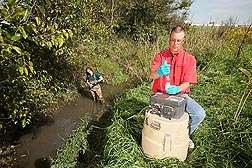Manure spills: Detailing the damage, finding a fix

A manure spill that reaches a nearby creek or river can create a serious environmental hazard because it significantly boosts phosphorus loads in the water. Now scientists at the U.S. Department of Agriculture (USDA) and their research partners have determined how channel sediments capture and release manure phosphorus, and have identified strategies for reducing phosphorus loads from manure spills.
Agricultural Research Service (ARS) soil scientist Doug Smith and Shalamar Armstrong, who is now an assistant professor at Illinois State University, conducted several studies on the issue. Smith works at the ARS National Soil Erosion Research Laboratory in West Lafayette, Ind. ARS is USDA's chief intramural scientific research agency.
The scientists collected sediments from two drainage ditches in Indiana's Cedar Creek Watershed. They added the sediments to an artificial water channel and used swine manure minimally diluted with water to create their own worst-case manure "spill." After 24 hours, they cleaned up the "spill" using standard remediation protocols.
The researchers found the spill simulation initially resulted in an average dissolved phosphorus concentration of 5.57 milligrams per liter, as measured in a water column. The concentrations dropped to between 0.19 and 0.21 milligrams per liter 24 hours later, but still exceeded U.S. Environmental Protection Agency (EPA) standards for rivers, stream, and drainage ditches in the Cedar Creek Watershed.
The scientists found that channel sediments initially adsorbed phosphorus from the water at rates ranging from 8.9 to 16.7 milligrams per square meter of sediment per hour. However, after the simulated "cleanup," all the sediments released phosphorus back into the water at rates that increased phosphorus loads to levels that exceeded EPA's maximum acceptable levels by at least 67 percent.
In another study, the researchers observed that amending the contaminated sediments with 1.6 milligrams of alum/calcium carbonate per gram of sediment suppressed phosphorus release in sandy sediments by 92 percent, and suppressed phosphorus release in clay loam and loamy sand sediments by 72 percent. Higher amendment levels suppressed phosphorus release in all three soil types by up to 100 percent.
Findings from the studies were published in the Journal of Environmental Quality and the Journal of Environmental Monitoring.
More information: Read more about this research in the March 2013 issue of Agricultural Research magazine.
Journal information: Journal of Environmental Quality , Agricultural Research
Provided by Agricultural Research Service















